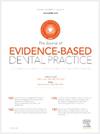干细胞在牙髓再生中的功效:系统综述
IF 4
4区 医学
Q1 DENTISTRY, ORAL SURGERY & MEDICINE
引用次数: 0
摘要
再生根管治疗(REPs)旨在再生坏死或感染牙髓的结构和功能完整性,同时促进根的发育和闭合。传统的治疗方法往往不能有效地再生牙髓组织。方法通过以下研究数据库和注册库进行电子检索:PubMed(包括MEDLINE和PubMed Central)、Scopus、Cochrane Central Register of Controlled Trials (Central)、谷歌Scholar和ClinicalTrials.gov。该研究已在PROSPERO上注册,并遵循PRISMA指南报告审查结果。应用纳入和排除标准后纳入了19项原始研究,包括1项随机临床试验和18项动物研究。这些研究评估了不同类型的牙髓治疗,包括髓盖、髓切开术、髓切开术和功能修复,使用各种类型的间充质干细胞,如牙髓干细胞、骨髓源性干细胞和脐带间充质干细胞(UCMSCs)。研究评估的结果包括牙髓再生、根尖周放射性的消退和牙齿活力的恢复。实验与动物实验系统评价中心(sycle)和偏倚风险2.0分别用于评估动物研究和随机试验的偏倚风险。结果干细胞治疗具有诱导牙髓再生的潜力。然而,由于在动物研究中使用的方法和结果测量方法的差异,与传统方法相比,综合干细胞治疗的总体疗效仍然具有挑战性。尽管存在这些不一致之处,大多数动物研究报告了牙髓再生的阳性结果,无论干细胞类型、支架类型或使用的动物模型如何。值得注意的是,一项利用脐带间充质干细胞(UCMSCs)联合血小板缺乏血浆的临床试验显示,牙髓血运重建和再灌注的效果良好。结论干细胞治疗再生牙髓治疗(REPs)的长期安全性和临床疗效需要通过随机临床试验验证,然后才能广泛应用于临床。本文章由计算机程序翻译,如有差异,请以英文原文为准。
EFFICACY OF STEM CELLS IN ENDODONTIC REGENERATION: A SYSTEMATIC REVIEW
Introduction
Regenerative endodontic procedures (REPs) aim to regenerate structural and functional integrity of necrosed or infected dental pulp, while promoting root development and closure. Conventional treatment methods often fail to regenerate dental pulp tissues effectively. This systematic review investigates the efficacy of stem cell therapy in REPs.
Methodology
An electronic search was conducted on the following research databases and registers: PubMed (includes MEDLINE and PubMed Central), Scopus, Cochrane Central Register of Controlled Trials (CENTRAL), Google Scholar, and ClinicalTrials.gov. The study was registered in PROSPERO and PRISMA guidelines were followed to report the review. 19 original studies comprising 1 randomized clinical trial and 18 animal studies were included after applying inclusion and exclusion criteria. The studies evaluated different types of endodontic procedures, including pulp capping, pulpotomy, pulpectomy, and furcation repair, using various types of mesenchymal stem cells, such as dental pulp stem cells, bone marrow-derived stem cells and umbilical cord mesenchymal stem cells (UCMSCs). The outcomes assessed in the studies included pulpal regeneration, resolution of periapical radiolucency, and restoration of tooth vitality. The Systematic Review Center for Laboratory and Animal Experimentation (SYRCLE) and Risk of Bias 2.0 was used for assessing the risk of bias in animal studies and randomized trials, respectively.
Results
The findings indicate that stem cell therapy holds promise for inducing dental pulp regeneration. However, synthesizing the overall efficacy of stem cell therapy compared to conventional methods remains challenging due to variations in methodologies and outcome measures used in animal studies. Despite these inconsistencies, most animal studies reported positive results for pulpal regeneration, regardless of the stem cell type, scaffold type or animal model used. Notably, a clinical trial utilizing umbilical cord mesenchymal stem cells (UCMSCs) combined with platelet-poor plasma demonstrated favorable outcomes in dental pulp revascularization and reperfusion.
Conclusion
The long-term safety and clinical efficacy of stem cell therapy in regenerative endodontic procedures (REPs) require validation through randomized clinical trials before widespread clinical adoption.
求助全文
通过发布文献求助,成功后即可免费获取论文全文。
去求助
来源期刊

Journal of Evidence-Based Dental Practice
DENTISTRY, ORAL SURGERY & MEDICINE-
CiteScore
6.00
自引率
16.70%
发文量
105
审稿时长
28 days
期刊介绍:
The Journal of Evidence-Based Dental Practice presents timely original articles, as well as reviews of articles on the results and outcomes of clinical procedures and treatment. The Journal advocates the use or rejection of a procedure based on solid, clinical evidence found in literature. The Journal''s dynamic operating principles are explicitness in process and objectives, publication of the highest-quality reviews and original articles, and an emphasis on objectivity.
 求助内容:
求助内容: 应助结果提醒方式:
应助结果提醒方式:


